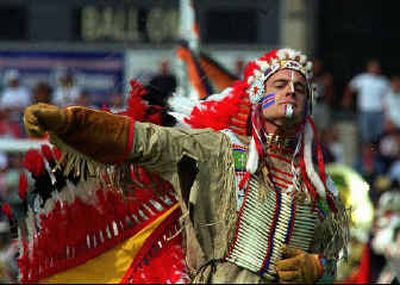NCAA again studies Native American mascots

He was a no-show at college basketball’s Final Four in St. Louis last month, but make no mistake: Illinois’ headdress-bedecked Chief Illiniwek was not forgotten.
A fixture at the school for almost 80 years, dancing during intermission of Illini athletics contests, the Chief continued to stir emotions and debate – conspicuous by his absence as the Illini played beneath the Gateway Arch for a national championship. Is he an homage to American Indians and their place in Illinois history?
Or, as critics contend, is he an offensive racial stereotype?
The university, while insisting the character is a “tradition” and not a mascot, has weighed the issue since the 1980s. Opponents sued two months ago, asking a Cook County, Ill., court to bar his appearances.
Chief, who largely doesn’t perform away from home, is one of the most visible targets of a broad review by the NCAA, which itself is measuring modern sensibilities and weighing whether the governing body can and should impose a ban on all Native American nicknames and mascots. Its decision is due in August.
“I think member institutions now understand the seriousness of this issue,” says Robert Vowels, commissioner of the Southwestern Athletic Conference and chairman of the NCAA’s Minority Opportunities and Interests Committee.
“People are telling you that in some instances it’s hurtful, it’s discriminatory, it’s degrading. When you have those types of issues and sentiments coming out, you have to take a serious look at it.”
Thirty schools in Divisions I, II and III were ordered by the NCAA to assess their use of Indian nicknames, mascots or logos and file reports by May 1. They’ll be reviewed first by Vowels’ committee, then by an NCAA executive committee subcommittee on gender and diversity issues, and finally by the presidents and chancellors who sit on the full Executive Committee.
Interestingly, the diversity subcommittee will be headed by Alcorn State president Clinton Bristow. Also a member of Vowels’ conference, Alcorn State calls its sports teams the Braves and is among those under NCAA scrutiny.
Not the first look
The Minority Opportunities and Interests Committee already has weighed in once on the Indian mascot question, declaring in an October 2002 report that “it is time for this tradition to be retired.”
But the panel went on to “acknowledge and support member institutions’ self determination on this issue.”
Officials acknowledge it could be difficult to go beyond that. A ban would have to pass legal muster, says the NCAA’s Corey Jackson, who works closely with Vowels’ committee.
“As far as just an outright ban, I think that’s possible. I don’t know how probable it is,” Jackson says. “There could be legislation regarding fines, maybe. It’s really tough to tell at this particular point.”
The NCAA counts seven member schools that use Indians as a nickname, six that use Braves, six that use Warriors and a handful of others that borrow from individual tribes: Chippewas, Choctaws, Fighting Sioux.
Almost all those schools say the intent is to honor American Indians. Many cite decades of tradition. Several, including Florida State, point to relationships with specific tribes and permission to use Indian imagery.
North Carolina at Pembroke, for example, was founded specifically to educate the region’s sizable Indian population, and its admission was restricted to Indian students for 70 years until the late 1950s. Its nickname is the Braves, and its logo – designed by an American Indian – depicts an Indian with a hawk on his shoulder.
A letter from interim education dean Zoe Locklear, a Lumbee Tribe member, to the NCAA cites the “connectedness of this institution to its American Indian heritage” and says “feelings around this issue run high in the community, especially among native peoples who want the logo left as is.”
Criticism of other schools, however, ranges from charges of racism to the perpetuation of historically inaccurate stereotypes to outright sacrilege – misappropriating feathers, costumes and dances that are used by American Indians in religious ceremonies.
While Pembroke claims an “irrefutable right” to use its nickname and logo, it maintains “institutions without clear and legitimate Indian origins do not have such a right.”
Some progress made
Elsewhere, a handful of schools has yielded to the political heat.
Southeast Missouri State originally was on the NCAA’s list of scrutinized schools but replaced its Indians nickname with Redhawks and, in January, announced a new mascot and logo.
Marquette, which won the 1977 NCAA men’s basketball tournament as the Warriors, dropped the name and its Indian mascot in 1993.
Marquette reaffirmed its refusal to reinstate the nickname just last week, though it’s having trouble coming up with a widely acceptable replacement.
Division III Carthage (Wis.), which declined either to provide USA Today with its response to the NCAA or comment beyond a 1994 policy statement, intends to keep Redmen for its men’s teams.
Division I St. John’s, however, which reached the 1985 Final Four as Redmen, changed its name to the Red Storm in the early 1990s.
Another stance
Since 1993 Wisconsin has had a policy against playing teams with Native American nicknames unless it has no control over the scheduling, such as in the postseason.
Short of imposing an outright ban, the NCAA may measure progress in such increments.
“I was talking to some folks,” says the SWAC’s Vowels, “and they were trying to explain to me that every symbol, every caricature, every name might have different significance. Sometimes, it’s whether feathers are up or down. There’s symbolism there that we all don’t know about.
“What I’ve gotten from people I’ve talked to – some of the tribes and some of the American Indians – is that if we can raise awareness, educate people on what’s going on, that’s a start.”